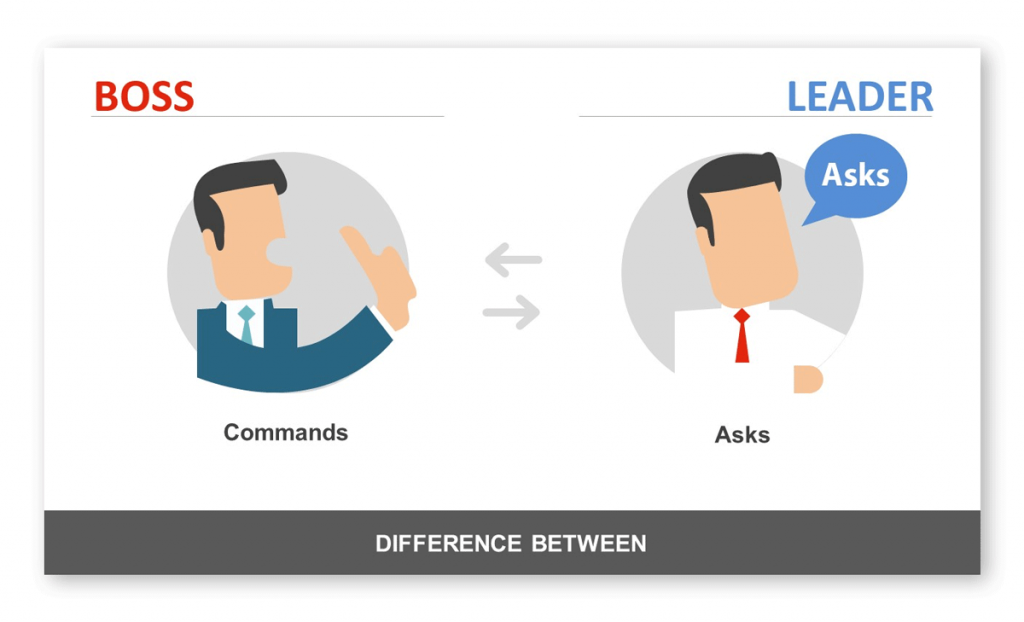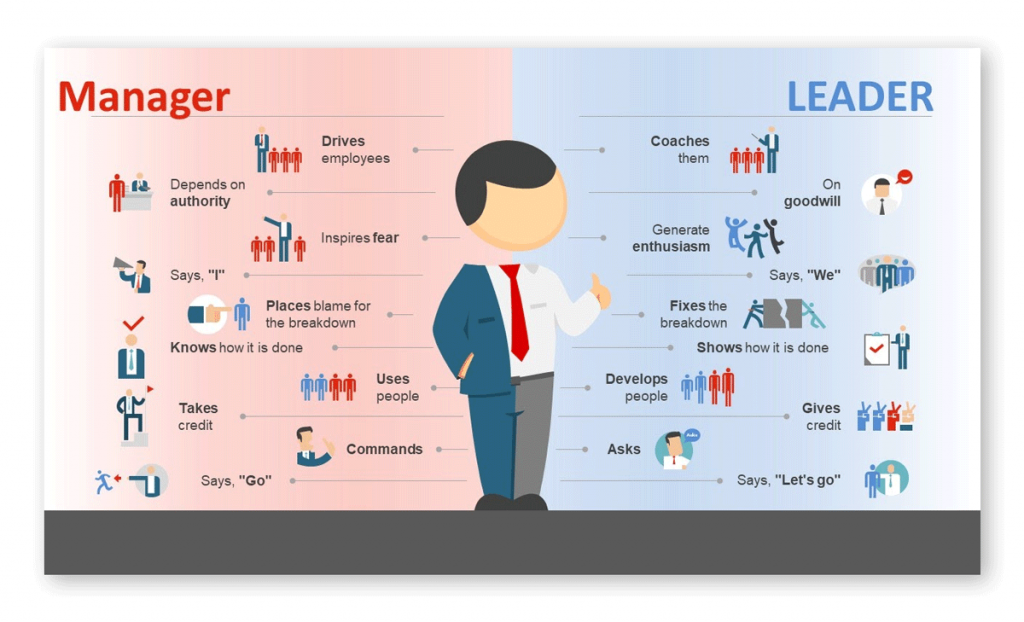
Many managers assume that they are providing leadership to their subordinates, however that might not be true! There is a distinct difference between leadership and management. This difference not only lies in the form of standard definitions but the way a team is managed or led by an individual. Let’s take a look at the 10 key differences between leadership vs management, with a few interesting illustrations from the Manager vs Leader PowerPoint Template.
Definitions: Leader vs Manager
Before we dig into the differences between leadership and management, let’s take a look at a few standard definitions of a leader and manager. Since various terms can have different interpretations, we have picked a few standard definitions most relevant to our topic.
A Leader:
“A person who leads a group of people, especially the head of a country, an organization, etc.”.
Oxford Dictionary
“A person in control of a group, country, or situation”.
Cambridge Dictionary
“A person who leads such as; a person who has commanding authority or influence.”
Merriam-Webster Dictionary

A Manager:
“A person who is in charge of running a business, a shop/store or a similar organization or part of one.”
Oxford Dictionary
“The person who is responsible for managing an organization.”
Cambridge Dictionary
“A person whose work or profession is management.”
Merriam-Webster Dictionary

10 Key Differences between Leadership and Management
From the aforementioned standard definitions, you might have realized that there are some key differences between leadership and management, especially in terms of how both “influence” subordinates. Let’s unpack these differences in a bit more detail.
1. Leaders Lead by Example, Managers Manage Teams
While a leader might set an example and influence subordinates and peers, a manager might simply manage teams in a standard way. For example, a manager who isn’t recognized by peers and subordinates as someone with true leadership capabilities might simply be followed as an instructor, who organizes schedules, assigns tasks, and forwards reports to senior management.
On the contrary, a leader might be seen as someone who mentors his subordinates, lead by example, takes on the most difficult and challenging tasks, and raises the bar for his team to try to match his hard work, intellect and skills.
2. Leaders Inspire Action, Managers Manage Activities
While a leader might inspire his/her team to try to come up with new ideas, to improve the quality of work and complete tasks under challenging deadlines; a manager might have a more mechanical approach.

A manager might simply manage a team which works according to a set routine, based on assigned tasks with little or limited motivation.
Many managers also face the dilemma of being unable to inspire their teams and even fail to maintain discipline, which leads to resentment, petty politics, unnecessary delays and a decline in the quality of work delivered from a team.
Recommended reading: Servant Leadership – Key Principles for Managers
3. Leaders Innovate, Managers Organize
One of the key traits which sets leaders apart from managers is their ability to innovate and come up with new and improved methods of getting tasks organized.
Many Total Quality Management techniques have led to improvement and innovation. A good example of this is Kaizen, which aims at improving activities for all workers through consultation and collaboration. This includes everyone from the CEO to the blue collar worker at the assembly line. The cycle of this Total Quality Management technique entails a Plan – Do – Check – Act approach. In fact, in many organizations workers are given the authority to suggest improvements in case of any identified abnormality. It is worth pointing out that concepts such as Kaizen can only be implemented where the workforce is truly motivated and the workforce has more “leaders” than “managers” who can innovate and inspire the workforce.
4. Leaders Take Risks, Managers Cautiously Plan
This is one of the trickiest part of being a leader: Taking risks. Leaders are prone to taking risks, which is a two edged sword. Risks are called “risks” for a good reason; since they can lead to an awful outcome. Nonetheless you can’t expect to do something groundbreaking without taking risks. The problem lies in balancing the risks with the potential to recover from a bad decision and this is what good leaders do quite well. This is not to say that many renowned leaders didn’t bet everything they had to take risks, which might or might not have paid off. A good example of this type of leadership is from Jeff Bezos. Despite having a high paying job at Wall Street, Bezos sacrificed everything to start an online bookstore by the name of Amazon in 1994. This was a time when Internet usage was low and people were only beginning to realize the power of the .com industry. He not only left his job as the Senior Vice President at D. E. Shaw but also began a business which was unlikely to yield any real profit for many years to come. In fact, Bezos himself warned early investors that there was a 70% possibility of his venture going bankrupt.
While managers who fail to become leaders are cautious and this might work for many individuals in their careers; risks are arguably the stepping stones for true leaders.
5. Leaders Inspire Change, Managers Bring Stability
While risks can lead to great rewards, however you don’t want too many people within an organization with a risk taking attitude! Leaders can inspire change with their personality, however an organization also needs people who bring stability and that includes people who are risk averse.
Managers, as compared to people with leadership qualities can be risk averse, and that can help bring stability to keep the wheel moving forward smoothly for an organization. The right mix of people capable of steady day to day management and inspiring leaders within an organization can be a blessing.
For example, many organizations have managers who provide a stable working environment; whereas Directors often come up with innovative solutions, and inspire the workforce with their charm, charisma and foresight. Furthermore, leaders can help inspire change, especially to counter resistance to a new method or procedure and to encourage continuous improvement via methods like Kaizen.
6. Leaders Plan for the Future, Managers Shoulder Immediate Responsibilities
Every organization needs a leader who can think ahead and consider the changing conditions of the market. Jeff Bezos started with an online retail store and expanded it into the largest e-store in the world. In fact, it is hard to think of a conventional store which provides products as diverse as Amazon.
This change could not have been possible in the mid 90s when Amazon was launched. However, as Internet usage expanded, so did Amazon. Bezos saw this many years before the Internet boom. While a steady management can help keep things running smoothly, it is the leader who truly envisions the future and the direction of the organization.
7. Leaders are Proactive, Managers are Reactive
If you have had the misfortune of working with incompetent management, you would know that managers, especially ones with little vision or skill are often reactive. They fail to listen to hard working and competent subordinates and react to a bad situation once it’s created. Unfortunately, many competent managers which lack leadership abilities do the same. They are not proactive since they are risk averse. This in turn leads to fewer initiatives and a clogged system where even a minor change can result in a breakdown.
Leaders, on the contrary, are proactive and keep the workforce motivated and ready to push through bottlenecks. Managers can often lack the adaptability of situational leadership, which can help them mould their subordinates according to the situation and changing market needs. This is why when many people in the management get stuck, they look to their bosses to move things forward, such as a Director or CEO.
Related read: Toxic leadership article.
Interestingly, many times this type of leadership is inspired by junior team members who can end up having more respect than their bosses due to their competence, intellect, hard work and a proactive, charming personality.
8. Leaders Build Shared Values, Managers Focus on Workforce Management
What drives many modern organizations are shared values. While managers can focus on workforce management, leaders build shared values and inspire corporate culture. Leaders inspire values that drive an organization and motivate employees to move forward to achieve desired goals. The shared values are synced with the goals of an organization and are often translated into taglines that can help inspire the workforce. Managers lack the ability to build their own values, since they are too short sighted to do so or find it hard to muster enough support to build an environment where they can inspire change.
9. Leaders Motivate, Managers Instruct
When your boss asks you to get something done, you have one of two feelings. One, you might want to get the job done somehow, which is all about getting paid for your job. Two, you might want to get the task done with perfection because you don’t want to led down your boss and want him to consider you can someone reliable. The latter is a trait which often requires motivation.
While many new employees in an organization might have the latter attitude at the beginning of a new job, their motivation can quickly dwindle in the wake of poor leadership, lack of encouragement, petty politics at the workplace and numerous other factors.
A leader knows how to keep his/her employees motivated and away from a toxic environment. They try to cater for the needs of the employees at a personal level and provide perks which might keep them motivated. For example, an organization may offer company stocks, play areas, good health insurance, annual bonuses and other perks to keep employees motivated and working hard for the benefit of the organization. Similarly, a mechanism of punishment can ensure that employees feel obliged to comply. A method better known as transactional leadership.

A leader can inspire a feeling that makes the employee feel as if he/she has a personal stake in the business. Some even do it without being able to offer much to their subordinates. This is how most successful companies begin as startups.
10. Leaders are Charismatic, Managers are instructive
There are people at the office that you casually greet every day. And then there are people who everyone likes to be around. Some people have a vibe which can make others feel happy and excited. That is the vibe of a true leader. A good sense of humor, expert knowledge, and a confident personality; all these things inspire people, and leaders often have more than one of these traits. Charisma can be enjoyed by people regardless of their leadership style. A leader can be charismatic despite practising an autocratic leadership style. However, other leadership styles are likely to have more charm such as someone who practices a strategic leadership style, transformational leadership style, team leadership style or cross-cultural leadership style. Perhaps the trickiest is the democratic leadership style, as keeping multiple people happy and willing to follow you with motivation is nothing short of an art.
Final Words
A leader is not defined by his position in the hierarchy, but it is rather an attitude, a capability to lead and inspire others which makes a leader. You might find more leadership in a junior member of the workforce rather than a dull CEO who lacks the capability to aptly lead an organization. In fact, it is not too uncommon to find people in leadership positions lacking the ability to lead. These people can often end up relying on others to do the leadership part for them or may eventually sink an organization because of their incompetence. Many government or semi-government organizations from around the world have been marred by this dilemma. In such monopolistic organizations there is often a lack of leadership from the top management which makes the organization inefficient. These organizations find it hard to survive in the wake of competition from the private sector. A glance at most government run telecom operators from around the world would show you just that. Very few government run telcos were able to diversify in time to account for the shift from landline phones to wireless technology. This resulted in many of these organizations running on government bailouts or facing hefty losses.
Leadership is a trait that is not defined by the position an individual is able to acquire in an organization but rather a capability which is easy to recognize based on how one delivers desired outcomes and inspires others. This is not to say that people who lack leadership qualities are worthless. The world will always have a need for inspiring leaders, as well as people who offer stability by remaining risk averse and bringing stability to organizations through their steady management.


